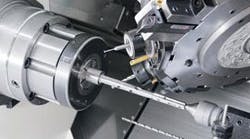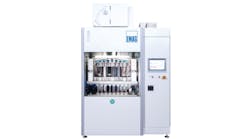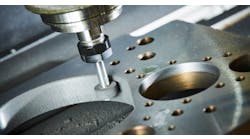To machine the gun bolt for a lever action rifle, a firearms manufacturer uses three tools simultaneously to reduce cycle time reductions. Because the bar stock becomes the fixture, no additional fixtures are necessary to produce complex shapes with tight geometric tolerances.
The firearms manufacturer switched to a three-turret configuration to produce three different parts in a total volume 40,000 parts per year. The production sequence had involved nine operations to complete the part, in a single-part flow with numerous with numerous time-consuming changeovers. Labor and scrap rates were high, and production was too slow to achieve competitiveness. By putting the process on a twin-spindle, three-turret, 2-Y axis multitasking lathe, the parts were machined complete from bar stock in a single machine with no changeovers, in just 7 minutes.
It was as true 20 years ago as it is today: successful milling and turning operations have always demanded a close examination of processes that will yield optimal productivity, profitability, and part quality. However, in contrast to the past, today’s tools, technology, and global competitive environment are very different.
Historically, every shop had about the same level of technology – generally a lathe, vertical mill and grinder. To stay ahead of the competition, job shop owners and manufacturing engineers needed to be more creative with the equipment than the next shop.
Today it is the advancements in technology that keep shops ahead of the competition. Multitasking machines are a great example. Multitasking became a "buzz word" about 15 years ago, even though the old cam-driven screw machines were actually multitasking back in the 1800s. They were accomplishing this mechanically rather than electronically, applying two or three tools in the cut.
Multitasking advances
Machine tool builders started making CNC lathes with backworking spindles. This allowed the back side of a part to be completed on one machine. Some builders began making true opposing twin spindles with 2 turrets and milling capability. The turrets had 12 stations, with six stations that could mill at about 2 or 3 horsepower (HP).
These platforms allowed manufacturers to reduce cycle time by as much as 50%, and give greater quality with less handling of the work piece. Complete parts could be produced in one machine. This twin spindle and two turrets configuration became popular because it enabled manufactures to increase production and reduce cost.
In just a few short years builders were adding a Y-axis to this platform. The Y-axis significantly increased productivity by allowing shops to work on one machine to produce more complex parts with features that were not on centerline.
The next significant change occurred because U.S. manufacturing became part of the global economy. U.S. manufacturers had to compete with countries like China, Mexico, India, Turkey and others, where the cost of goods sold is lower than in the U.S because labor is considerably less expensive. Manufacturers in the U.S. simply cannot compete based on labor rates that may be as low as $0.50 to $2.00 an hour.
U.S manufacturers started to lose lot of work to other countries. Many of the high-volume products in manufacturing jobs are given to the lowest bidder. In some cases, the cost of raw material in the U.S. is more than another country’s finished product. This left the U.S. manufacturers producing only low-volume, high-quality products. Twin spindle, twin turrets multitasking machines are good technology for some applications, but short-run production jobs present a challenge for keeping costs low enough to be profitable. Costs are greater because there is long setup time on short runs.
In response, the U.S. needed advancements in multitasking technology to address the changing manufacturing environment. Machine tool builders rose to the challenge by delivering a twin spindle with a B-axis tool spindle, replacing the 12-station turret. Essentially this is a turning machine with a tool spindle like a machining center. The tool spindle offers good horsepower at 10, 15 and 20, the ability to change tools like a vertical mill and a Y-axis capability.
This technology also added the tool magazine to the machine, allowing for 40, 60, 80, 100 or more tools. This design of multitasking allows for a reduction in setup time because the tools stay resident in the tool magazine and do not need to be removed. Complex parts can be machined complete, including intricate angle features, because a B-axis tool spindle can change to any angle as easily as a new program position.
Although this technology did reduce the setup time, with only one B-axis tool spindle the true multitasking advantage of maximizing with two tools in the cut was lost. Cycle times were actually increasing.
To address this, a lower turret was introduced. Some builders even offer machines with two lower turrets. Also, there are machines with lower turrets that have milling capability and a Y-axis.
The lower turret technology made it possible to reduce cycle and setup times for manufacturing small lots of complex parts. Now, many complex defense components and intricate medical products are manufactured very effectively with this multitasking technology.
Today some of the manufacturing is coming back to the U.S Many U.S. manufacturers are opting to use American labor because they have discovered product-quality issues on jobs outsourced to other countries. Also, the cost of shipping goods has been rising steadily.
Three turrets, tremendous efficiency
However, U.S. manufacturers need to reduce costs even more to increase productivity and keep the work here, and advancements in multitasking lathe technology can offer significant benefits. Machine tools builders now offer turning systems with a twin spindle (20-30 HP), and three turrets with all turrets Y-axis capable. The three turrets provide 36 to 72 tool stations - capable of 10 HP milling at 40 Nm torque on all stations.
This current technology allows production of a family of parts with complex features. Using three tools simultaneously in the cut can produce dramatic cycle time reductions. And, since the bar stock actually becomes the fixture, no additional fixtures are necessary to produce complex shapes with tight geometric tolerances. A useful example of this is a domestic firearms manufacturer that recently revised its production process for the gun bolt of its lever action rifle.
The volume was 40,000 parts per year, and there are three different calibers 300 Win, Mag, and 338 Win. They had performed nine operations to complete the part. All the operations were a single-part flow, and changeover to other sizes was time consuming. The labor and scrap rates were high. They were losing sales because they could not produce the parts fast enough.
By putting the process on a twin-spindle, three-turret, 2-Y axis multitasking lathe, a three-turret configuration was used because of the number of tools required (31). The result? The part was machined complete from bar stock in a single machine with no changeovers — in 7 minutes. One machine provided a full production solution.
Both short and long production runs can be made with great efficiency because no setup time is required. The three turrets with multiple tools resident mean that no tool changes are needed: the operators can change the bar size or workholding, call up a new program, and start making the part.
Today there also have been notable improvements in the manufacturing of the milling heads used on these machines. The manufacturers are using better bearings, even using four bearings instead of three. Some are using Timken roller bearings for greater rigidity. They have high-pressure "coolant thru" capability and are offering quick-change systems, too.
There are many advantages to multitasking today, the best being the reduction in process time or cycle time for producing completed parts. Even with complex parts a mill/turn lathe has many advantages. With all the different machine configurations 2 turrets, 3 turrets, 3 turrets with Y-axis or a B-axis tool-changing machine — the possibilities are endless.
This does not mean that a horizontal machine or a 5-axis milling machine can be replaced with a mill/turn lathe, However, when it comes to productivity and profitability, multitasking is hard to beat. So how do you know when to consider a mill/turn process? The simple answer is that any part with turning, drilling or boring, O.D or I.D threads, and a few mill features, such as a square hex, even a bolthole pattern, can be produced effectively with a mill/turn operation. These are very basic part configurations, and there arguably is no better way to produce these types of parts than on a multitasking machine.
Now, what about thinking out of the box: Imagine you need to produce 20,000 pieces/year of a custom hydraulic manifold block. The part is 303 stainless steel, 7/8 in. thick X 1.350 in. wide X 4.100 in. long.
There are 2.25 -18 NPT holes on each side (a total of eight), and a 0.5-in hole through the center of the 4.100 length. There is a special round boss on the two ends with an O-ring groove and a 0.25-20-bolthole pattern for mounting.
This description sounds like a good horizontal machining application. However it could be made in a multitasking turning center. For comparison, here are the two machining processes, hypothetically illustrated:
The multitasking process offers a faster cycle time due to more tools in the cut simultaneously. You would need to run the horizontal a full second shift to meet your production needs. The tooling cost should be about the same for either process. This is just a rough example, but the projected savings in productivity and finished-part costs can make "thinking out of the box" a very profitable proposal, and make your operation more competitive. To maximize profits even further, manufacturers can achieve "lights out," unattended operation, lowering manufacturing costs and raising marginal profit, using simple automation tools like magazine bar-feeders, multi-pallet machines, and robotics. Unattended running is much more feasible today. The machine tool manufacturers are supplying software features like tool-load monitoring and tool-life management to make "lights out" running highly successful.
Richard Parenteau is the director of Applications Development and Nakamura-Tome product manager at Methods Machine Tools Inc.
| Tips for Implementation When a shop first decides it would like to implement multitasking technology here are some basic, helpful guidelines: 1. Choosing the Right Personnel 2. Changing the approach to your part manufacturing 3. Selecting software Wait codes (M100-M199) are used to synchronize the two programs (left and right spindles); when a wait code is commanded by one control, the control hangs up (wait ) until a matching wait code is commanded in the opposite control. They are used to avoid interference between the two programs, such as crossing over from one spindle to the other or conflicting turrets between the two while working on the same spindle. With the programming software you can utilize the wait codes to optimize the process and verify that there is time to add a second operation while another is in process again, multitasking. Good levels of simulation and post-processing capabilities are now available. Most viable CAM systems produce a good part the first time. 4. Finding a quality machine tool |






